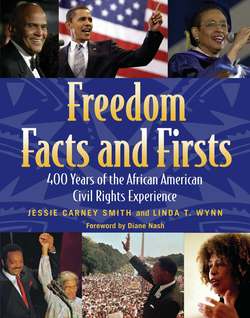Читать книгу Freedom Facts and Firsts - Jessie Carney Smith - Страница 106
На сайте Литреса книга снята с продажи.
Tallahassee Movement
ОглавлениеTallahassee’s modern movement for civil rights began in May 1956, when Carrie Patterson and Wilhemina Jakes, students from Florida Agricultural and Mechanical University (FAMU), were arrested for sitting in the white section of a Tallahassee public transit bus. Their arrest and the subsequent cross burning at their rooming house sparked a citywide boycott of Tallahassee’s public transit system. Because of the arrest and cross burning, at a mass meeting FAMU’s students voted to boycott city buses. Patterson and Jakes’s actions galvanized the black community and launched a desegregation campaign similar to the Montgomery Bus Boycott, which began in December 1955. Under the leadership of the Reverend Charles K. Steele, the Inter-Civic Council (ICC) coordinated the logistics of the mass demonstration. As the bus boycott continued, numerous people were arrested for giving car rides to the boycotters, which filled the jails to overcapacity.
On November 13, 1956, the U.S. Supreme Court affirmed the lower court ruling in the Browder v. Gayle case. Litigated by civil rights attorney Fred Gray, it held that bus segregation was unconstitutional. Later, the ICC suspended the boycott, and the transit system stopped enforcing racially segregated seating. However, refusing to acquiesce to the nation’s highest tribunal, nine white bus drivers and the company manager were arrested for allowing blacks to sit in the front of the bus in violation of the local segregation rules. Florida’s Governor Leroy Collins suspended all bus service in Tallahassee. In January 1957, a federal judge ruled that all of the state’s bus segregation laws were unconstitutional, so Collins allowed bus service to resume on a desegregated basis.
Federal troops set up mess tents at the site of the 1908 Springfield, Illinois riots (Library of Congress).
The Tallahassee Bus Boycott only foreshadowed the winds of change that were empowering the black community. Similar to other southern cities, Tallahassee was slow in surrendering its links to the Old South mentality and its resistance to a new racial order. After all, it was built on the presumption of white superiority and black inferiority. During the 1950s and 1960s, the Florida panhandle was as much a part of the Deep South as Alabama, and as noncompliant with the change in race relations.
In the summer of 1959, Miami’s chapter of the Congress of Racial Equality (CORE) conducted a workshop on direct nonviolence that was attended by FAMU students Priscilla and Patricia Stephens. Later, they organized a CORE chapter in Tallahassee on FAMU’s campus and became key organizers of the student sit-in movement in Tallahassee. Tallahassee’s chapter planned two sit-in demonstrations against segregated variety stores’ lunch counters in February 1960. The first sit-in occurred on Saturday, February 13, in the downtown area at Woolworth’s when Stephens and ten other students attempted to order food. Similar to what happened with the group of students in the Nashville Student Movement, their first attempt yielded neither service nor major incident. However, the second sit-in of February 20 led to eleven arrests and eight sentences of 60 days in jail or $300 in fines when students refused to move. Five students, including Priscilla and Patricia Stephens, chose to remain in the Leon County Jail for the full sentence. Like Martin Luther King Jr., who penned the “Letter from the Birmingham Jail” three years later, during her 49 days of incarceration from March 18 to May 5, 1960, Patricia Stephens penned a “Letter from the Leon County Jail.” Stephens’s letter demonstrated that students across the sit-in movement were willing to accept incarceration as a tactic against segregation. Tallahassee’s directaction campaigns continued as Stephens led students in other forms of direct non-violent protests, including the freedom rides, voter registration, the desegregation of movie theatres and other public accommodations. They also worked with white students from neighboring Florida State University to begin the deliberate process of racial desegregation.
Linda T. Wynn
Hate groups such as the White Citizens Council and the Ku Klux Klan terrorized the makeshift city by firing shots into the tents.
